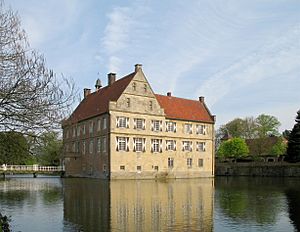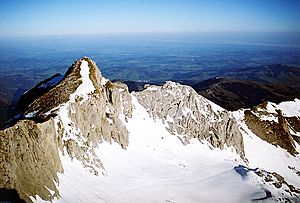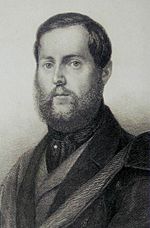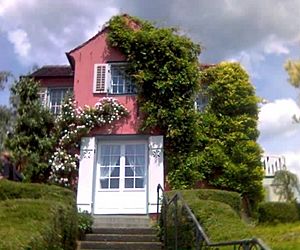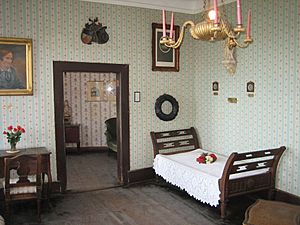Annette von Droste-Hülshoff facts for kids
Quick facts for kids
Annette von Droste-Hülshoff
|
|
|---|---|
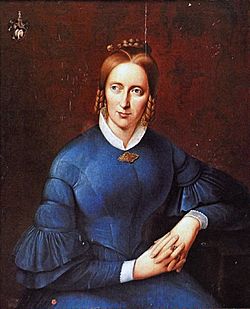
Portrait by Johann Sprick, 1838
|
|
| Born | Anna Elisabeth Franziska Adolphine Wilhelmine Louise Maria von Droste zu Hülshoff 10 January 1797 Havixbeck, Prince-Bishopric of Münster, Holy Roman Empire |
| Died | 24 May 1848 (aged 51) Meersburg, Grand Duchy of Baden |
| Occupation | Writer |
| Nationality | German |
| Period | 19th century |
| Genre | Poetry, Novella |
Baroness Anna Elisabeth Franziska Adolphine Wilhelmine Louise Maria von Droste zu Hülshoff, known as Annette von Droste-Hülshoff (10 January 1797 – 24 May 1848), was a famous German poet, novelist, and composer from the 19th century. She is especially known for her short novel Die Judenbuche.
Many people consider her one of Germany's greatest female writers. Her poems, especially those about nature, are very special. They show her unique talent and creativity.
Contents
Biography
Early Life and Education
Annette von Droste-Hülshoff was born at Burg Hülshoff castle in Havixbeck, Germany. Her family was part of the old Roman Catholic nobility in Westphalia. Her father, Clemens August von Droste zu Hülshoff, loved history, languages, nature, music, and even mysterious things. Her mother, Therese Luise, also came from a noble family.
Annette was the second of four children. She was born a month early and had health problems throughout her life, like headaches and eye issues.
She was taught at home by private teachers. She learned ancient languages, French, natural history, math, and music. She was very talented in music, just like her father. Annette started writing when she was a child. We still have about 50 poems she wrote between 1804 and 1814.
Annette often visited her mother's family at Schloss Bökerhof. Here, she met important writers like the Brothers Grimm. She and her sister even shared folk tales from Westphalia for the Grimms' famous collection of fairy stories. However, most people around her didn't really encourage her writing at first. Only one literary figure, Anton Matthias Sprickmann, saw her talent. She showed him many of her early works.
Personal Challenges and Early Writings
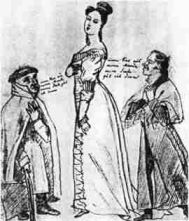
Around 1819, Annette stayed with her relatives at Schloss Bökerhof. She hoped to improve her health at a nearby spa. During this time, she became close to Heinrich Straube, a law student who loved literature.
However, a difficult situation arose involving some of her relatives. They did not approve of her relationship with Straube. Another aristocrat, August von Arnswaldt, pretended to be interested in Annette. He then used this to cause a misunderstanding between Annette and Straube. This situation caused Annette much sadness and affected her personal life. She never saw either man again and felt betrayed by her relatives. Because of this, she didn't visit Schloss Bökerhof for 18 years.
After this difficult time, Annette's writing became more original. In 1820, she started a series of religious poems called Das geistliche Jahr ("The Spiritual Year"). She wanted to write one poem for each Sunday and church holiday as a gift for her grandmother. But the poems were very personal and showed her own spiritual doubts, so she didn't publish them. They were only published after she passed away.
When her father died in 1826, Annette moved with her mother and sister to a small home called Rüschhaus. Life there was quiet and simple. She wrote poetry, but not a lot. In 1834, her sister Jenny married Baron Joseph von Laßberg, who was interested in old German poetry. Annette visited him at his castle in the Swiss Alps. The beautiful scenery inspired her, but her brother-in-law and his friends didn't appreciate modern literature, so they couldn't help her publish her work.
Annette then asked two friends to help publish her first book. It came out in 1838, but it didn't sell well. She found this very disappointing.
Literary Success
Things changed for Annette in 1840. She met a young poet named Levin Schücking. He had written a positive review of her first book. Schücking asked for her help with his own book, Das malerische und romantische Westfalen ("Picturesque and Romantic Westphalia"). They became close friends, and Annette wrote several poems for his book.
Schücking encouraged her to write more. In 1840-1841, she wrote her famous short novel Die Judenbuche (The Jew's Beech). It was based on a real event that happened near Bökerhof. The next year, Annette and Schücking stayed at her brother-in-law's castle at Meersburg by Lake Constance. Schücking told her that her best talent was in lyric poetry, which comes from special moments of inspiration. Annette agreed and started writing many poems, about fifty between October 1841 and April 1842.
These poems included ones for Schücking, often about getting older. She also wrote poems where she looked at herself, like "Das Spiegelbild" ("The Image in the Mirror"). Her nature poems, collected in "Heidebilder" ("Heath Pictures"), are very famous. They include "Die Krähen" ("The Crows") and "Der Knabe im Moor" ("The Boy on the Moor"), which sometimes have a touch of mystery or supernatural fear.
In April 1842, Schücking left Meersburg. Annette returned to Rüschhaus. Their close friendship began to change. Annette wrote fewer poems, but she did create some more, like the mysterious story "Spiritus familiaris." In September 1844, a well-known publisher released a large collection of her poems from the 1840s. This time, Annette was very successful! Many important thinkers praised her work. The famous pianist Clara Schumann even asked her to write an opera story for her husband, Robert Schumann. Over time, Annette von Droste-Hülshoff became known as the greatest female German writer of her century.
Final Years
Her friendship with Schücking eventually cooled. In 1843, Schücking married Louise von Gall. When they visited Annette in Meersburg in 1844, the two women didn't get along well. Annette published a poem called "Lebt wohl" ("Farewell"), which was like saying goodbye to Schücking. Schücking also wrote things that showed their friendship was changing.
Despite this, after Annette's death, Schücking helped share her works with the world. He published a collection of her last poems and a full edition of her collected works. Some important poems from her final years include "Mondesaufgang" ("Moonrise") and "Im Grase" ("In the Grass").
The money she earned from her successful book helped Annette buy a small house called Fürstenhäusle in Meersburg. She lived in the old castle from 1846 until her death in May 1848, likely from tuberculosis.
Her Poetry Style
Annette von Droste-Hülshoff was a unique and independent writer in German poetry. She understood the power of imagination, like the Romantic writers of her time. But her poems were different. They were not vague or overly emotional. She didn't care about what was popular at the time. She once wrote, "I do not want to become famous now, but in a hundred years' time I would like to be read."
She was ahead of her time because she paid close attention to details and described things very precisely. She combined imaginative ideas with accurate observations of reality. This makes her a bridge between the Romantic style and the more realistic writing that came later in the century.
Musical Activity
Annette learned to play the piano and sing from a young age. She even studied a book on musical composition. She wrote 74 songs and started four operas, though they were never finished. Although she didn't write an opera for Robert Schumann, he did set one of her poems, "Das Hirtenfeuer," to music.
Works
- Gedichte (Poems, 1838)
- Die Judenbuche (novella, 1842)
- Gedichte (Poems, 1844)
- Westfälische Schilderungen ("Westphalian Illustrations", 1845)
- Das geistliche Jahr (The Spiritual Year, cycle of poems, 1851)
- Letzte Gaben ("Last Gifts", poems, 1860)
- Briefe von Annette von Droste-Hülshoff und Levin Schücking (Letters from Annette von Droste-Hülshoff and Levin Schücking)
- Lieder mit Pianoforte-Begleitung. Componirt von Annette von Droste-Hülshoff (Songs, posthumously edited 1871 by Christoph Bernhard Schlüter)
See also
 In Spanish: Annette von Droste-Hülshoff para niños
In Spanish: Annette von Droste-Hülshoff para niños


